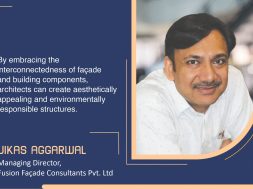Why is an integrated approach important in façade design?

As environmental consciousness and escalating energy demands drive the Indian construction industry to become increasingly energy efficient, Vikas Aggarwal illuminates how an integrated approach to façade design is catalysing this change.
Although aesthetic appeal is one of the foremost considerations, there is growing recognition of the need to prioritise holistic building performance and sustainability. This transformation’s heart is integrated facade design, a strategic approach that acknowledges the interconnectedness and symbiotic relationship of structures, façade systems, insulation, and living spaces. This perspective has leveraged the pathway to creating effective facade designs that are visually captivating, functionally superior, and environmentally sustainable.
Synergy through integration
Traditionally, facade design has often treated components in isolation, leading to several inefficiencies and missed opportunities. However, embracing an integrated approach provides a wealth of synergistic benefits. For example, efficiently incorporating high-performance insulation and rear ventilated façade systems can significantly influence space utilisation and energy efficiency. This is exemplified by projects like 76 South Avenue, a residential building in Mumbai, where replacing traditional walls with insulated cladding systems reduced heat loads and structural loads and saved floor space index (FSI).

Balancing aesthetic appeal and energy efficiency
Integrated facade design facilitates the optimisation of natural lighting while minimising heat gain. By strategically incorporating glazing elements and light-diffusing materials within the facade, daylight penetration can be maximised while controlling heat ingress. This approach creates more comfortable, productive, and efficient indoor environments and contributes to significant energy savings while allowing for creative architectural expressions. The Reliance Corporate Park is an ideal example, where low-U-value double-insulated glass and insulated cladding systems have helped achieve remarkable energy efficiencies while contributing to a visually striking facade.
Solar energy and design integration
The integration of solar-responsive roofing/cladding materials further amplifies the benefits of this holistic approach. By incorporating photovoltaic panels or thermal collectors, buildings can generate renewable energy and achieve significant energy independence, especially in countries like India, which is blessed with abundant solar resources. This integration reduces the carbon footprint and offers opportunities for innovative designs.
Dynamic facades enhance both functionality and visual impact
In the era of artificial intelligence (AI), dynamic facades integrated with building management systems (BMS) offer many opportunities for optimising building performance. AI/BMS can pre-program automated ventilation and cooling adjustments based on seasonal variations, minimising energy consumption. This approach represents the future of facade design and overall building efficiency, where visual appeal and energy efficiency work synergistically. Integrated facade design is an example of a paradigm shift in our construction industry, focusing on achieving a harmonious balance between aesthetics, functionality, and performance.
For more details, visit: https://fusionfacades.co.uk/
Cookie Consent
We use cookies to personalize your experience. By continuing to visit this website you agree to our Terms & Conditions, Privacy Policy and Cookie Policy.










